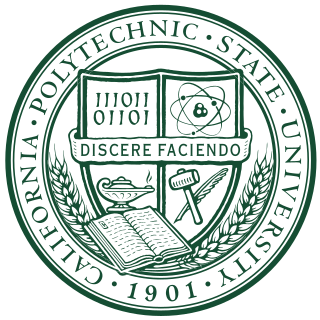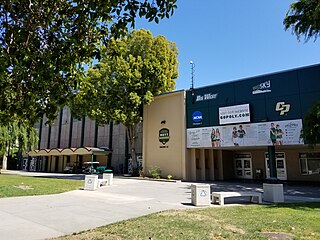Related Research Articles

San Luis Obispo is a city and county seat of San Luis Obispo County, in the U.S. state of California. Located on the Central Coast of California, San Luis Obispo is roughly halfway between the San Francisco Bay Area in the north and Greater Los Angeles in the south. The population was 47,063 at the 2020 census.

California Polytechnic State University is a public university in San Luis Obispo, California. Founded in 1901, It is the oldest of three polytechnic universities within the California State University system. Cal Poly emphasizes a “learn by doing” philosophy, integrating hands-on, practical experiences into its curriculum. As of Fall 2022, Cal Poly had approximately 21,000 undergraduate and 800 graduate students. Cal Poly is well-regarded for its undergraduate programs, having been ranked 1st among Regional Universities in the Western US in the 2025 U.S. News & World Report rankings. The university is home to several nationally recognized programs, particularly in engineering, architecture, and business, with the College of Engineering and the Orfalea College of Business standing out for their academic excellence and industry connections. Most of the university's athletic teams participate in the Big West Conference.

California State Polytechnic University Pomona, is a public polytechnic university in Pomona, California. It is the largest of the three polytechnic universities in the California State University system.

The Robert A. Mott Athletics Center is a 3,032-seat, indoor multi-purpose arena on the campus of California Polytechnic State University in San Luis Obispo, California.
KCPR is a non-commercial radio station that is licensed to San Luis Obispo, California. Owned by California Polytechnic State University in San Luis Obispo, the station is operated by students from its on-campus studio located in the Graphic Arts building. In addition to its FM broadcast, KCPR streams its programming online 24 hours a day and has established a growing social media audience.

Mustang Memorial Field, formerly known as Mustang Stadium and then Alex G. Spanos Stadium, is an 11,075-seat multi-purpose stadium located on the campus of California Polytechnic State University in San Luis Obispo, California. It is the home field of the Cal Poly Mustangs football and soccer teams.
Jordan David Beck is an American former professional football player who was a linebacker in the National Football League (NFL). He played college football at California Polytechnic State University, San Luis Obispo. He was selected by the Atlanta Falcons in the third round of the 2005 NFL draft. After leaving the Falcons, Beck signed with the Denver Broncos and was later released after the 2008 preseason.

The Cal Poly Mustangs are the football team representing California Polytechnic State University located in San Luis Obispo, California.

Warren J. Baker was an American academic administrator who was president of California Polytechnic State University. Baker was the eighth president of Cal Poly San Luis Obispo, holding the office from 1979 until 2010.

The Myron Angel House is a historic house located at 714 Buchon St. in San Luis Obispo, California. Built circa 1880, the house has a vernacular design which does not follow a particular architectural style. The two-story wood-frame house has redwood siding, a shingled gable roof, and some Eastlake details in the window surrounds and gable ends. The house was once the home of Myron Angel, the main figure in the establishment of California Polytechnic State University. Angel, who lived in the house from 1889 to his 1911 death, proposed and lobbied for the creation of a polytechnic school in California; it was mainly due to his campaign that Cal Poly was founded in San Luis Obispo. In addition to his educational activism, Angel was also an influential journalist and historian.
Alexander Bravo was an American football player. He played defensive back with the Los Angeles Rams and Oakland Raiders, as well as the Saskatchewan Roughriders in the Canadian Football League (CFL).
The 1928 Cal Poly Mustangs football team represented California Polytechnic School—now known as California Polytechnic State University, San Luis Obispo—as a member of the California Coast Conference (CCC) during the 1928 college football season. Led by eighth-year head coach Al Agosti, Cal Poly compiled an overall record of 3–4–2 with a mark of 1–2–1 in conference play, tying for fifth place in the CCC. The team was outscored by its opponents 90 to 45 for the season and was shut out in five of their nine games. The Mustangs played home games in San Luis Obispo, California.
The 1924 Cal Poly Mustangs football team represented California Polytechnic School—now known as California Polytechnic State University, San Luis Obispo—as a member of the California Coast Conference (CCC) during the 1924 college football season. Led by fourth-year head coach Al Agosti, Cal Poly compiled an overall record of 1–5 with a mark of 0–3 in conference play. The team was outscored by its opponents 193 to 19 for the season and was shut out by the Stanford freshmen, 97–0. The Mustangs played home games in San Luis Obispo, California.
The 1929 Cal Poly Mustangs football team represented California Polytechnic School—now known as California Polytechnic State University, San Luis Obispo—as a member of the California Coast Conference (CCC) during the 1929 college football season. Led by ninth-year head coach Al Agosti, Cal Poly compiled am overall record of 3–5 with a mark of 0–2 in conference play. The team was outscored by its opponents 146 to 130 for the season. The Mustangs played home games in San Luis Obispo, California.
The 1936 Cal Poly Mustangs football team represented California Polytechnic School—now known as California Polytechnic State University, San Luis Obispo—as an independent during the 1936 college football season. Led by fourth-year head coach Howie O'Daniels, Cal Poly compiled a record of 5–4. The team outscored its opponents 96 to 76 for the season. The Mustangs played home games at Mustang Stadium in San Luis Obispo, California.
The 1940 Cal Poly Mustangs football team represented California Polytechnic School—now known as California Polytechnic State University, San Luis Obispo—as an independent during the 1940 college football season. Led by eighth-year head coach Howie O'Daniels, Cal Poly compiled a record of 6–3. The team outscored its opponents 148 to 83 for the season.
The 1941 Cal Poly Mustangs football team represented California Polytechnic School—now known as California Polytechnic State University, San Luis Obispo—as an independent during the 1941 college football season. Led by ninth-year head coach Howie O'Daniels, Cal Poly compiled a record of 5–3–1. The team outscored its opponents 84 to 72 for the season. The Mustangs played home games at Mustang Stadium in San Luis Obispo, California.
The 1942 Cal Poly Mustangs football team represented California Polytechnic School—now known as California Polytechnic State University, San Luis Obispo—as an independent during the 1942 college football season. Led by Bob Dakan in his first and only season as head coach, Cal Poly compiled a record of 4–3. The team outscored its opponents 179 to 105 for the season.
Jose Antonio Garcia was a Californio bandit, born in Santa Barbara, Alta California, Mexico. He was suspected by the San Luis Obispo Vigilance Committee of being part of the gang of Pio Linares, and he was hung after making a confession exposing other members and the leadership of the gang as the participants in an 1857 robbery and murder of two French Basque cattlemen.

The Superior Court of California, County of San Luis Obispo, also known as the San Luis Obispo County Superior Court or San Luis Obispo Superior Court, is the California superior court with jurisdiction over San Luis Obispo County.
References
- ↑ Records of the US Military Academy, provided by Suzanne Christoff, Associate Director for Special Collections and Archives, USMA Library
- ↑ The Ovid Bee, September 26, 1860
- 1 2 Pinard II, Leo W. (August 17, 1981). "National Register of Historic Places Inventory - Nomination Form". Heritage Conservation and Recreation Service . Retrieved July 10, 2013.
- ↑ "Collection guide: Finding aid of the Myron Angel Papers, 1827-1911". Online Archive of California. The Regents of The University of California. Retrieved July 10, 2013.
- 1 2 3 4 Krieger, Dan (March 4, 2001). "The Making of an Educational Institution". The Tribune .
- ↑ "Conception". Department History. Cal Poly Department of Electrical Engineering. Retrieved July 10, 2013.
- ↑ "Founding Act". Department History. Cal Poly Department of Electrical Engineering. Retrieved July 10, 2013.
- ↑ Funeral Notice - Myron Angel, San Luis Obispo Tribune - June 28th, 1911